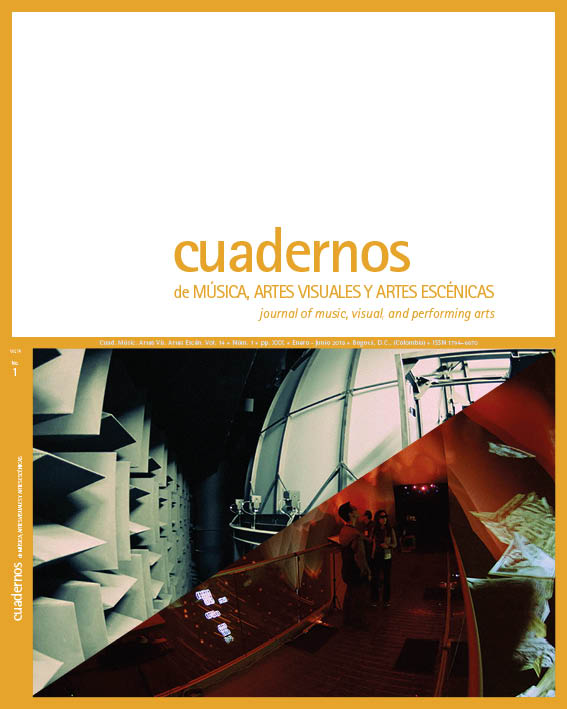Abstract
To represent the different sound phenomena, graphic notation— musical writing originated in the middle of the last century— uses a great variety of visual language elements. In this type of notation, the score acts not only as a record and motor of the musical experimentation carried out by the avant-garde composers, but also as a territory of trials and tests with the different visual languages. This article delves into the knowledge of the different visual languages used in the graphic notation with the purpose of understanding how the musical concept of each work and composer is related to the visual language chosen for its graphic representation. For this, an interdisciplinary study of certain representative works of graphic notation made from the mid-20th century to the present day has been carried out, selecting the visual languages of comics, collage, sculpture, video and film, photography and drawing. The research evidences the synesthetic nature of the graphic notation and highlights the creative nature of this form of musical writing, as a generator of new sound and artistic processes, as well as interpretative suggestions and resources. This article focuses on the study of graphic notation as a synesthetic, musical and plastic phenomenon. Additionally, it adopts as starting point the own visual language of each score in order to, based on it, understand how image and sound create a dialogue in each case, how musical thinking materializes in a work that is also plastic, and vice versa, how a plastic work generates new sound processes.
— 2009b. “The Weight”. En Notations 21, Theresa Sauer. Nueva York: Mark Batty Publisher.
Ariza, Javier. 2008. Las imágenes del sonido: una lectura plurisensorial en el arte del siglo XX. Cuenca:
Universidad de Castilla-La Mancha.
Balcells, Eugènia. 1981. “Flight”. http://www.eugeniabalcells.com/videos/flight/content.html.
— 1995. “Film Score”. http://www.eugeniabalcells.com/partituras/film/content.html.
Báthory-Kitsz, Dennis. 2007. “Lunar Cascade in Serial Time”. http://maltedmedia.com/people/bathory/music/pdf/
Berberian, Cathy. 1966. Stripsody. Leipzig: Edition Peters.
— 1966. Stripsody. Leipzig: Edition Peters.
Berenguer, Josep Manuel. 1993. “La continuidad, en el límite”. En Partitures plàstiques, 84-86. Barcelona: Balmes 21.
Bosseur, Jean-Yves. 2006. Musique et arts plastiques: interactions au XXe siècle. París: Minerve.
Cox, Christopher. 2004. “Visual Rounds: On Graphic Scores”. En Audio Culture, Revised Edition: Readings in Modern Music, editado por Christoph Cox y Daniel Warner, 187-188. Nueva York: Continuum.
Díaz Padilla, Ramón. 2007. El dibujo del natural: la época de la posacademia. Madrid: Akal.
Frith, Fred. 1992. “Skylight IV”. En Stone, Brick, Glass, Wood, Wire (Graphic Scores 1986-96). Bolonia: I dischi di Angelica.
Fugellie Videla, Daniela. 2012. “La música gráfica de León Schidlowsky: Deutschland, ein Wintermárchen (1979) como partitura multimedial”. Revista Musical Chilena 66 (218): 7-37.
Garbuglia, Andrea. 2011. Stripsody: la vocazione musicale delle strisce a fumetti. Macerata: Eum edizioni università di Macerata.
Hellerman, William. 1985. “Staff of Life II”. http://notationnotes.tumblr.com/post/6555013019/william-hellermann-staff-of-life-ii
— 2011. “Visible Music (The Score as a Sore to be Rubbed)”. PAJ: A Journal of Performance and
Art 33 (1): 85-92.
Hidalgo, Cristina. 2014. “Toshi Ichiyanagi: música, experimentación y recodificación del tiempo”. http://revistacultural.ecosdeasia.com/toshi-ichiyanagi-musica-experimentacion-y-recodificacion-del-tiempo/.
Hope, Cat y Lindsay Vickery. 2011. “Visualising the Score: Screening Scores in Realtime Performance”. https://ro.ecu.edu.au/ecuworks2011/429/
Kandinksy, Wassily. 1977. Punto y línea sobre el plano. Barcelona: Barral.
Maur, Karin von. 1999. The Sound of Painting: Music in Modern Art. Múnich: Prestel Verlag.
Mestres Quadreny, Josep Maria. 1993. “Las nuevas grafías musicales”. En Partitures plàstiques, 83-84. Barcelona: Balmes 21.
Moran, Robert. 1965. “Sketch for a Tragic One-Act Opera”.
Perejaume. 1988. En Partitures plàstiques (catálogo exposición), 53. Barcelona: Balmes 21.
Raine-Reusch, Randy. 1998. “Of Pine and Silk”. http://www.asza.com/scores/r3pine.shtml.
— 2009. “Of Pine and Silk”. En Notations 21. Nueva York: Mark Batty Publisher.
Raskin, Jon. 2009. “Jon Raskin”. En Notations 21, 184-185. Nueva York: Mark Batty Publisher.
Reih, Ravunial. 1993. “El ojo que prolonga el oído”. En Partitures plàstiques, 87-88. Barcelona: Balmes 21.
Sauer, Theresa. 2009. Notations 21. Nueva York: Mark Batty Publisher.
Schidlowsky, León. 1980. “Deutschland, ein Wintermarchen. Parte 2”. http://schidlowsky.com/Leon-Schidlowsky/galerien/graphics/02_1980_Deutschland_ein_Wintermaerchen_Teil_2.jpg.
Seco, Manuel, Olimpia Andrés y Gabino Ramos. 1999. Diccionario del español actual. Madrid: Aguilar.
Stoïanowa, Ivanka. 1973. “Musique, graphie, geste, musique, graphie”. Musique en jeu 13: 105-114.
Esta revista científica se encuentra registrada bajo la licencia Creative Commons Reconocimiento 4.0 Internacional. Por lo tanto, esta obra se puede reproducir, distribuir y comunicar públicamente en formato digital, siempre que se reconozca el nombre de los autores y a la Pontificia Universidad Javeriana. Se permite citar, adaptar, transformar, autoarchivar, republicar y crear a partir del material, para cualquier finalidad, siempre que se reconozca adecuadamente la autoría, se proporcione un enlace a la obra original y se indique si se han realizado cambios. La Pontificia Universidad Javeriana no retiene los derechos sobre las obras publicadas y los contenidos son responsabilidad exclusiva de los autores, quienes conservan sus derechos morales, intelectuales, de privacidad y publicidad.
El aval sobre la intervención de la obra (revisión, corrección de estilo, traducción, diagramación) y su posterior divulgación se otorga mediante una licencia de uso y no a través de una cesión de derechos, lo que representa que la revista y la Pontificia Universidad Javeriana se eximen de cualquier responsabilidad que se pueda derivar de una mala práctica ética por parte de los autores. Como consecuencia de la protección brindada por la licencia de uso, la revista puede publicar retractaciones o corregir la información ya publicada. La publicación de contenidos en esta revista no representa regalías para los contribuyentes.



